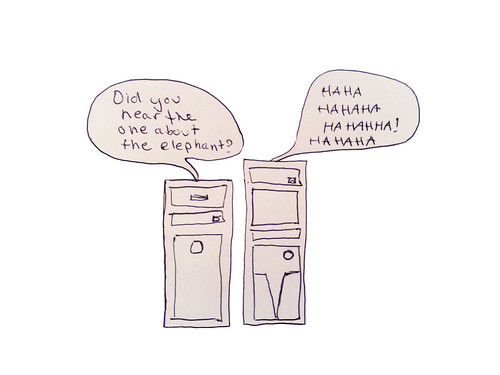

Interactivos? Mexico City -Technologies of Laughter, proposal by Jenny Chowdhury
“Catty CPU Cliques” imagines a future where the field of Computational Humor has progressed to a point where office computers no longer use humor to communicate with their users, but rather to alienate them.


Statement:
In most places of work, employees form alliances known as cliques where members are accepted into a group based on some criteria. Those who aren’t in a particular clique are seen as outsiders and often become alienated in the presence of those who are. The relationships between two employees can be ascertained by observation – members of cliques can be found in huddles by the water cooler or bathroom in states of comedic story telling and laughter. When an outsider arrives to the scene, laugher often gets quieter or ceases completely. The modulation in the laughter between two members of a clique can serve as an indication of their alliance, but also serves to alienate the outsider, reinforcing the preexisting relationships. Meanwhile, the drama inherent in office culture can temporarily be escaped by simply taking refuge at one’s desk in the company of non-judgmental computers. Or at least this was the case before computers knew how to tell jokes.
Scientists are currently conducting research into the field of Computational Humor, a branch of computational linguistics and artificial intelligence that uses computers in humor research. As Kim Binsted, a professor in Computer Science at University of Hawaii, stated in her paper Computational Humor, “ If computers are ever going to communicate naturally and effectively with humans, they must be able to use humor... In popular perception, computers will never be able to use or appreciate humor…Then again, chess too was once thought to be the sole domain of humans, and now computer programs play at the grandmaster level.”
This project predicts a near future where office computers, originally bestowed with humor to help them communicate with people, form cliques and use humor and laughter to exclude human workers. The installation envisions two computers sitting underneath desks in an office-like environment. When humans leave the desk area, the two computer monitors go blank and the computers physically slide together to laugh and “tell” each other jokes that are scraped from the internet (or are generated algorithmically). Laughter and hushed jokes emanating from the CPUs are loud enough to be heard from 15 feet away. However, when a person is sensed nearby (through an ir sensor or video sensing) the computers hush their laughter, they slide back to their places under desks and the monitors turn back on showing productivity software (excel for example), leaving the humans feeling excluded and as if they’ve missed something exciting and alienated as if they are no worthy of being let in on a joke. Occasionally, one of the computers will be unable to suppress a giggle even when humans are around and the laugher will become contagious and spread to the second computer.
“Catty CPU Cliques” imagines that in giving the computers tools to communicate more naturally with us, we’ve also given them tools to alienate us. In this scenario, it’s not about machines simply taking over the world, but rather a more subtle story of the machines taking the seemingly innocent and benevolent expressions of humor and laughter and using them exclude us.
Documentation
As the opening of the exhibition was the same day we finished the project and i needed to leave Mexico the next day, the documentation could be better. Most of it can be found here:
http://flickr.com/photos/jennylc/sets/72157608266949293/
Team
I had the pleasure of working with the following people for this project:
Petra Farinha
Hector Zarate
Emilio Zamudio Murillo
Adrián Santuario
Eduardo Alarcón
David Regla
Thanks to everyone at Media-Lab Prado, El Centro Cultural de Espana in Mexico and El Centro Multimedia and also to all the wonderful people who were involved with interactivos Mexico City.